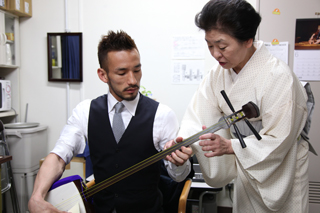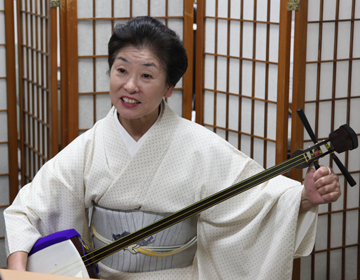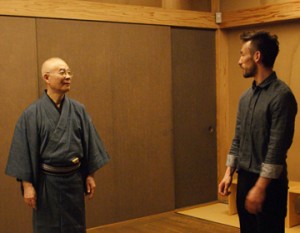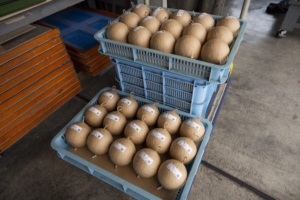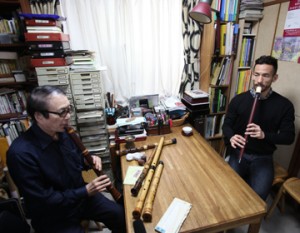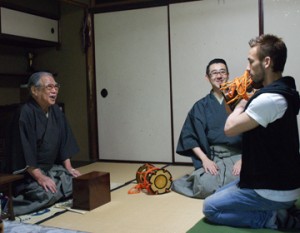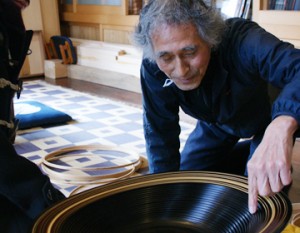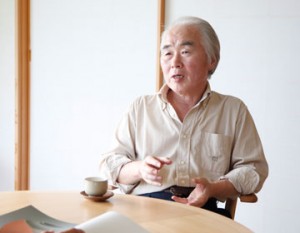Kamigata Music and Edo Music
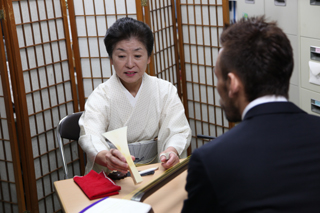
Katoubushi is a leading school of Edo Joururi, which is recognized as an Important Intangible Cultural Asset of Japan as a group. It was established in 1717 by the founder, known by the name Masumi Kato, who had served as an apprentice under Edo Handayu, said to be the founder of Handayu bushi. The strong sound of the stylish narration captivated the hearts of the Edo people.
Noh and Kyogen are both art that was derived in the Kamigata area: Kyoto and Osaka. In Kamigata, a type of music called Ichhubushi was born along with Gidayu style singing, which later came to Edo. From this, various types of music branched out, such as ”Tokiwazubushi”. Then the Edo-born, Edo-bred people made a Joururi style especially for Edo, which became Katoubushi. The Katoubushi shamisen is known for its high stringed pitch, whereas for Noh, the basic sounds are ”low pitch”.
Edo Joururi Expressed by High Pitch
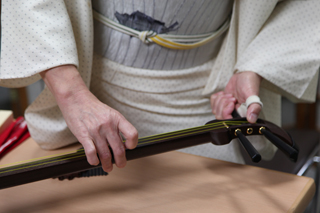
The musical scale is expressed by something called “Kan” and “Otsu”. “Kan” are the high pitch sounds and “Otsu” the low pitch. The Kamigata region places importance on the Otsu pitch and that is where the Japanese expression “It is Otsu (It is fine)” is derived. However Edo music used a lot of high pitch notes. This was a new trend of music created in the fields of Musashino. There was a great influx of people, and people had to use high pitch for the sound to be heard.” Takeuchi from the Kokyokukai Foundation explained.
This is the music loved by the Edo people with its vibrating sounds, a good match for the bustle of the city.
Kamigata Gidayu Bushi uses a very wide-bodied ”shamisen”, the Kiyomotobushi uses a moderately wide-bodied ”shamisen”, and the Katoubushi uses a thin-bodied ”shamisen”. The ”bachi” pick is thin and flexible.
Yamabiko Senko, recognized as a Living National Treasure for Katoubushi Shamisen, played us a tune. “Another characteristic of Katoubushi Shamisen is that you use the ”bachi” as though you are scooping up the string. You strum the string and let it vibrate by holding it up from the ”shamisen”. And then, you give a call, “Hauu” which is another characteristic.” Yamabiko played us a part of “Sukeroku” from ”Kabuki”, producing a splendid sound, which resonated to our soul.
Delicate Movements

We asked Yamabiko about ”tuning”. The strings are tightened or loosened before a performance. We witnessed Yamabiko doing this.
“The strings are silk, so the pitch is affected with the slightest change in environment, such as the stage light hitting them. Sometimes it loosens on stage, so we need to tune it.” she explained. If the adjustment can’t be done while on stage, she changes the positioning of her fingers on the strings. ”Shamisen” requires delicacy of the ears as well as the fingertips. Nakata also experienced for himself how difficult this can be.
The ”shamisen” is placed on your right thigh and the ”bachi” pick is held with your left hand. The ”bachi” is held ever so lightly by balancing it with just one pinky from the back.
“Then you use your right elbow as the support for the lever, and strum the strings.” Those were the instructions, but the center string is terribly difficult to reach. When playing the ”shamisen”, the left hand is constantly moving around, adding to the difficulty. However, Nakata commented, “When you’re actually able to make a sound, it gives you great satisfaction!” Yamabiko smiled and replied, “Yes, see what I mean?” ”Shamisen” has many different methods and schools based on the region, each with its own sound and expression. It was another encounter with the profound depth of Japanese cultural music.
